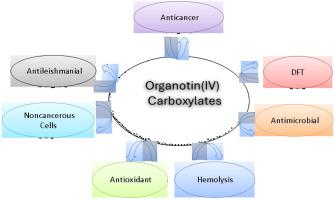新型三有机锡(IV)羧酸盐:合成、结构特征及抗菌、细胞毒性、抗氧化、溶血、抗利什曼原虫、抗癌研究
IF 2.1
3区 化学
Q3 CHEMISTRY, INORGANIC & NUCLEAR
引用次数: 0
摘要
合成了两种羧基配体h1 {(Z)-4-(对甲苯基氨基)-4-氧丁-2-烯酸}和HL2 {(Z)-4-(4-氟苯基氨基)-4-氧丁-2-烯酸)}及其六种新型三有机锡(IV)衍生物,通式为R3SnL(其中R = Me (1,4), Bu(2,5)和Ph(3,6)),并对其进行了表征和体外生物学应用评价。三有机锡(IV)配合物(1、2和4)的单晶XRD和FT-IR数据表明,它们本质上是聚合物,锡(IV)离子处于扭曲的三角双金字塔环境中。然而,多核核磁共振数据(1H, 13C, 119Sn)表明,(Me)3SnL、(Bu)3SnL和(Ph)3SnL化合物在溶液状态下保持了完整的聚合物三角双锥体几何结构,而(Bu)3SnL化合物5在非配位溶剂CDCl3中转变了四面体几何结构。利用B3LYP/LANL2DZ能级的DFT对它们的结构、电子和物理化学性质进行了详细分析,结果与单晶数据一致。此外,对它们的前沿分子轨道、Mulliken电荷和分子静电势面的研究为它们的结构-性质关系和物理化学性质提供了有价值的见解。体外研究检测了抗菌活性、细胞毒性、抗氧化特性、溶血、抗利什曼原虫效应和抗癌潜力,表明与相应的配体相比,复合物具有更高的功效。本文章由计算机程序翻译,如有差异,请以英文原文为准。

Novel triorganotin(IV) carboxylates: Synthesis, structural features and antimicrobial, cytotoxicity, antioxidant, hemolysis, antileishmanial, anticancer studies
Two carboxylic ligands, HL1 {(Z)-4-(p-toluidino)-4-oxobut-2-enoic acid} and HL2 {(Z)-4-(4-fluorophenylamino)-4-oxobut-2-enoic acid)} and their six novel triorganotin(IV) derivatives with the general formula R3SnL (wherein R = Me (1, 4), Bu (2, 5) and Ph (3, 6) were synthesized, characterized and evaluated for in vitro biological applications. Single crystal XRD and FT-IR data of the triorganotin(IV) complexes (1, 2 and 4) showed that they were polymeric in nature and that the tin(IV) ion was in a distorted trigonal bipyramidal environment. However, multinuclear NMR data (1H, 13C, 119Sn) suggested that the polymeric trigonal bipyramidal geometry remains intact for (Me)3SnL and (Bu)3SnL and (Ph)3SnL compounds in solution-state, whereas it switches tetrahedral geometry for (Bu)3SnL compound 5 which were analyzed for NMR in CDCl3, a non-coordinating solvent. A detailed analysis of their structural, electronic and physico-chemical properties, using DFT at B3LYP/LANL2DZ level, revealed results consistent with the single crystal data. Additionally, the study of their frontier molecular orbitals, Mulliken charges and molecular electrostatic potential surfaces provided valuable insights into their structure-property-relationship and physicochemical properties. In vitro studies examining antimicrobial activity, cytotoxicity, antioxidant properties, hemolysis, antileishmanial effects, and anticancer potential have demonstrated higher efficacy of complexes compared to their corresponding ligands.
求助全文
通过发布文献求助,成功后即可免费获取论文全文。
去求助
来源期刊

Journal of Organometallic Chemistry
化学-无机化学与核化学
CiteScore
4.40
自引率
8.70%
发文量
221
审稿时长
36 days
期刊介绍:
The Journal of Organometallic Chemistry targets original papers dealing with theoretical aspects, structural chemistry, synthesis, physical and chemical properties (including reaction mechanisms), and practical applications of organometallic compounds.
Organometallic compounds are defined as compounds that contain metal - carbon bonds. The term metal includes all alkali and alkaline earth metals, all transition metals and the lanthanides and actinides in the Periodic Table. Metalloids including the elements in Group 13 and the heavier members of the Groups 14 - 16 are also included. The term chemistry includes syntheses, characterizations and reaction chemistry of all such compounds. Research reports based on use of organometallic complexes in bioorganometallic chemistry, medicine, material sciences, homogeneous catalysis and energy conversion are also welcome.
The scope of the journal has been enlarged to encompass important research on organometallic complexes in bioorganometallic chemistry and material sciences, and of heavier main group elements in organometallic chemistry. The journal also publishes review articles, short communications and notes.
 求助内容:
求助内容: 应助结果提醒方式:
应助结果提醒方式:


